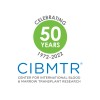
Study of DSP-7888 in Patients With Myelodysplastic Syndrome
Myelodysplastic SyndromeThis is a phase 1/2, uncontrolled, open-label, multicenter study in patients with MDS for whom no effective therapies currently exist.

Phase 1 Study to Evaluate MEDI4736 in Subjects With Myelodysplastic Syndrome
Myelodysplastic SyndromeThis is a multicenter, open-label, Phase 1 study to assess the safety and antitumor activity of MEDI4736 as Monotherapy or in Combination with Tremelimumab with or without Azacitidine in Subjects with myelodysplastic syndrome after treatment with hypomethylating agents

Organ-Sparing Marrow-Targeted Irradiation Before Stem Cell Transplant in Treating Patients With...
Adult Acute Lymphoblastic Leukemia in RemissionAdult Acute Myeloid Leukemia in Remission13 moreThis pilot clinical trial aims to assess feasibility and tolerability of using an LINAC based "organ-sparing marrow-targeted irradiation" to condition patients with high-risk hematological malignancies who are otherwise ineligible to undergo myeloablative Total body irradiation (TBI)-based conditioning prior to allogeneic stem cell transplant. The target patient populations are those with ALL, AML, MDS who are either elderly (>50 years of age) but healthy, or younger patients with worse medical comorbidities (HCT-Specific Comorbidity Index Score (HCT-CI) > 4). The goal is to have the patients benefit from potentially more efficacious myeloablative radiation based conditioning approach without the side effects associated with TBI.

Treosulfan/Fludarabine/Low Dose TBI as a Preparative Regimen for Children With AML/MDS Undergoing...
Acute Myeloid Leukemia (AML)Myelodysplastic Syndrome (MDS)This is a prospective, open-label, nonrandomized, prospective clinical trial evaluating a fixed regimen of treosulfan, fludarabine and low-dose total body irradiation (TBI) in children with acute myeloid leukemia (AML) and myelodysplastic syndrome (MDS) undergoing allogeneic hematopoietic cell transplantation (HCT). The primary hypothesis is that HCT with a preparative regimen consisting of treosulfan, fludarabine and low-dose TBI will result in overall survival (OS) comparable to historical rates observed with conventional myeloablative regimens in the pediatric population. The preparative regimen will result in adequate incidence of neutrophil and platelet engraftment, and acceptable rates of graft-versus-host disease (GVHD), relapse and survival. The pharmacokinetic (PK) profile of treosulfan in children will be comparable to that of adults previously studied.

Study of ACE-536 for the Treatment of Anemia in Patients With Myelodysplastic Syndromes (MDS)
AnemiaThe purpose of this study is to evaluate the effects of ACE-536 on anemia in patients with low or intermediate-1 risk MDS.

Donor Natural Killer Cells and Donor Stem Cell Transplant in Treating Patients With High Risk Myeloid...
Accelerated Phase Chronic Myelogenous LeukemiaBCR-ABL1 Positive16 moreThis phase I/II trial studies the side effects and best dose of donor natural killer cells when given together with donor stem cell transplant and to see how well they work in treating patients with myeloid malignancies that are likely to come back or spread. Giving chemotherapy, such as busulfan and fludarabine phosphate, before a donor peripheral blood stem cell transplant helps stop the growth of cancer cells. It may also stop the patient's immune system from rejecting the donor's stem cells. When the healthy stem cells and natural killer cells from a donor are infused into the patient they may help the patient's bone marrow make stem cells, red blood cells, white blood cells, and platelets.

Use of Hyperbaric Oxygen Therapy to Improve Umbilical Cord Blood Stem Cell Homing and Subsequent...
Acute Myeloid LeukemiaAcute Lymphoblastic Leukemia3 moreBy doing this study, researchers hope to learn the following: If providing hyperbaric oxygen (HBO) therapy prior to an umbilical cord blood (UBC) transplant will help to improve the homing process The safety of HBO administration in the setting of the UBC transplant The effects of HBO therapy on the engraftment process

Fludarabine Phosphate, Clofarabine, and Busulfan With Vorinostat in Treating Patients With Acute...
Acute Lymphoblastic Leukemia in RemissionAcute Myeloid Leukemia in Remission5 moreThis phase I trial studies the side effects and best dose of vorinostat when given together with fludarabine phosphate, clofarabine, and busulfan in treating patients with acute leukemia that is under control (remission) or has returned (relapse) undergoing donor stem cell transplant. Vorinostat may stop the growth of cancer cells by blocking some of the enzymes needed for cell growth. Drugs used in chemotherapy, such as fludarabine phosphate, clofarabine, and busulfan, work in different ways to stop the growth of cancer cells, either by killing the cells, by stopping them from dividing, or by stopping them from spreading. Giving vorinostat together with fludarabine phosphate, clofarabine, and busulfan before a donor stem cell transplant may be a better treatment for patients with acute leukemia.

Azacitidine After Chemotherapy and Donor Lymphocyte Infusion in Patients With Relapsed Acute Myeloid...
LeukemiaMyeloid2 moreThis phase I trial studies the effects and safety of adding azacitidine (5-AzaC) to the standard of care (Soc) for patients with relapsed acute myeloid leukemia (AML) or myelodysplastic syndrome (MDS) after being treated with donor stem cell transplant. SoC includes giving an infusion of the donor's white blood cells (donor lymphocyte infusion or DLI) to boost the anticancer effects of the transplant. Giving 5-AzaC after DLI may alter the function of T-cells resulting in reduced incidence of graft versus host disease (GVHD) while maintaining the anticancer effects.

Bone Marrow Transplantation of Patients in Remission Using Partially Matched Relative Donor
Acute Myeloid LeukemiaMyelodysplastic Syndromes8 moreThe primary hypothesis of this research study is that patients in remission undergoing myeloablative haploidentical hematopoietic stem cell transplantation (HSCT) on the Thomas Jefferson University (TJU) 2 Step treatment regimen will have a disease-free survival (DFS) rate at 1 year that is the same or better than the historical DFS of patients with similar diagnoses and ages undergoing matched sibling HSCT. Based on a review of the literature a DFS rate of 50% or better at 1 year would meet the criterion for an effective alternative therapy. A DFS rate of 75% or better would imply superior efficacy of the TJU 2 Step approach over T-replete matched sibling HSCT.
